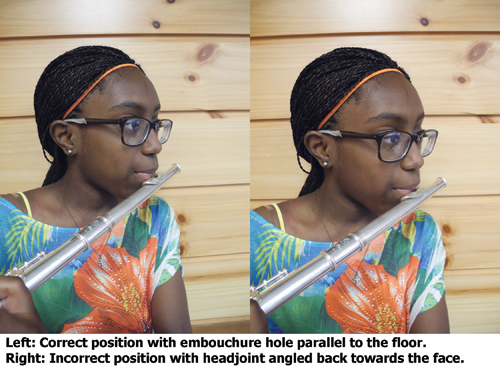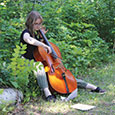If you conduct, coach, or perform in a flute choir, intonation comes up at every rehearsal or performance. Flute choirs usually have players at varying levels of advancement and talent, which can make intonation a tricky problem.
Flute choir intonation begins with the headjoint. Check the cork placement of each person’s headjoint including the headjoints of the alto, bass, and contrabass flutes. When the cleaning rod is inserted into the headjoint, the line on the cleaning rod should appear in the center of the embouchure hole. To ensure correct placement, look at the embouchure hole from both sides and adjust accordingly. Within the ensemble you may find that some flutist’s corks are too tight and others are too loose. If the cork is too tight, there is a possibility the flute will tune on the flat side, with a dull sound. If the cork is too loose, then it is impossible to set the proper placement of the cork simply because the cork will not stay in place. Poorly fitted corks should be replaced by a qualified repair craftsman. A well-fitted cork should be tapered to match the taper in the headjoint. The cork should be checked regularly and replaced when necessary. A replacement may be necessary every six months to several years depending on the humidity level where the flutist lives. The stem of the cork assembly should be replaced every few years or when the plate at the end of the screw becomes scratched.
Once the cork is in the proper place, check to be sure each flutist is playing the headjoint with the embouchure hole level with the floor. While it is easier to play with the headjoint angled back toward the player’s face, this compromised angle affects the intonation by making the octaves too small. Flutists should practice in front of a mirror to learn to keep the embouchure hole level. Many players find it difficult to play in this position because they have not developed control of the embouchure. Playing octaves on the headjoint a few minutes each day will quickly develop the embouchure.

Aligning the Headjoint on the Piccolo, C Flute, and Straight Alto Flute
Since the goal is to keep the embouchure hole level when playing, insert the headjoint into the body of the instrument and align it so that an imaginary line may be drawn through the center of the right-hand keys (D, E, F) and up through the center of the embouchure hole. When the headjoint of metal instruments is properly aligned, use a permanent pen to place several vertical lines around the tube of the headjoint and body to guide the player in assembling the flute correctly each time.
Aligning Curved Head Flutes
With the larger flutes, it is important to adjust the headjoint to the body of the instrument so the player is comfortable when playing, and the balance of the instrument in the hands causes no pain. Do adjust the headjoint so the embouchure hole is always level when playing.
Pulling Out
Each instrument should be pulled out somewhat. A good rule to follow is: for piccolo pull about 1/8 inch, for flute about 1/4 inch, for alto 3/8+ inch, for bass 1/2+. Use a ruler to check this measurement as many people have a poor eye for measurements. For the curved headjoints, pull out at the joint closest to the embouchure plate. Check the final tuning on several notes throughout the range with a tuner.
Warm-up
Each flute choir rehearsal should begin with twenty to thirty minutes of unison warm-up because the first step in learning to play in tune is matching the interval of the unison and the octave. For the first part of the warm-up I prefer that each flutist plays a C flute. (During a flute choir performance each member of the group should have the opportunity to play piccolo, C flute, alto and bass. While most flutists prefer one or more of the flutes, it is better for their development as a musician and flutist if they regularly play a variety of parts.)
Many flute choirs practice scales, arpeggios, and seventh chords in unison using the 17 Big Daily Exercises by Taffanel & Gaubert, The Flute Scale Book by George & Louke, or Unisonal Scales by William C. White. When using this material, be creative. If there is a difficult rhythm in one of the flute choir repertoire pieces, play this rhythm on scales, arpeggios, or seventh chords. Be sure to include a variety of articulation patterns so the group reads and performs these patterns in the same style and with good intonation. In the best chamber ensembles, each member of the group is able to vibrate in cohort with the other members of the ensemble. Practice scales with 2, 3, 4, or 5 unison vibrato to MM=60-72 to develop this skill.
If the flute choir plays without a conductor (Orpheus Chamber Music style), an amplified metronome is useful in getting each flutist to play on the beat. Often the weakest members of the ensemble play before the beat. This impairs intonation because the weakest person plays the note early and sets where intonation is. If each member plays exactly on the beat, the stronger players determine where intonation is, and the group will sound better in tune.
Rhythm books such as the 150 Original Exercises in Unison for Band or 101 Rhythmic Rest Patterns by Grover C. Yaus played with the metronome are also excellent materials to use with a flute choir. Members of the flute choir should agree on the note length of each note they play and the amount of space between the notes. If the members are playing the same rhythms, it is easier to discuss and solve this issue.
The Thumb Problem
If a flutist does not have the flute balanced well in his hands, it will roll back towards the player when the left thumb is removed (for C 5, 6, 7; C# 5, 6, 7; G6, and Ab6). Each player should be cognizant when playing one of these notes and strive to keep the keys level with the floor. If a flute does slip back, the flutist should rotate the flute out when he replaces his thumb on the key. The embouchure hole and keys remain level at all times.
Differential Tones
Differential tones are produced when two flutists play in thirds in the second and third octave. These tones are often referred to as creating a buzz. Actually the phenomenon occurs when you subtract the number of vibrations of the lower note from the upper note. The resultant tone is a much lower note. Working to produce a strong differential tone develops good intonation habits. To play differential tones have a group of flutists play an ascending chromatic scale in whole notes with half starting on C6 and the rest starting on A5.
Special Fingerings
If flutists are playing new scale instruments (instruments made after approximately 1985), the third octave F# is better in tune when using the right hand middle finger. Adding the F and E keys when playing Aflat6 will lower the pitch nicely. There are several books and online sources which offer sensitive fingerings to use in problematic places. These fingerings should not be used when playing fundamentals such as scales, but used in particular places (usually on held notes) in the repertoire.
Dynamics
Flute choirs have a tendency to play everything at the mf level. When practicing in unison, vary the dynamics so each member gains control of the intonation whether he is playing at p or f levels. Generally flutists play flat in piano passages and sharp in forte ones. Flutists often play third octave notes on the sharp side and the lowest notes on the flat side.
Adding the Piccolo and Big Flutes
If a flute choir spends 30 minutes playing in unison, those flutists playing piccolo, alto, or bass flute should change to their auxiliary instrument for the last 10 to 15 minutes of the warm-up session. Since alto flutes are pitched in G, alto players must transpose in order to play in unison with the other members of the flute choir. The note a flutist fingers on an alto flute sounds a perfect 4th lower.
Tuner
Each member of the ensemble should practice slow scales and arpeggios with the tuner regularly. They should know the pitch tendencies of the instruments and make adjustments as necessary while playing.
Air Stream
Many flute choirs suffer from intonation problems because each and every member of the choir fails to play with a fast enough air stream. The coach or conductor should remind flutists to blow and direct the air stream to a place on the wall directly in front of them for good projection.
Fortunately, flutes manufactured today are constructed on an excellent scale with high tolerances for accuracy. Following these simple suggestions will improve even the most elementary ensemble’s intonation.






